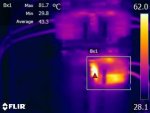10-2013 http://forums.mikeholt.com/showthread.php?t=156764&highlight=metal+halide+tripping+breakers Augie47 started a thread about something similar. I couldn't see that he ever reported a resolution.
In our case, the school built the new field three years ago. They started with a 100kVA POCO transformer serving a 600 amp, 240 volt panel. There are 9 poles and 12 circuits, all at 240 volts. The Metal Halide fixtures are 1500 watt. There are banks with 4 lights on some and 5 on others. Since the first day they have been dealing with random nuisance tripping of the circuit breakers. They started with 40 amp breakers and now there is a mix of 50 and 60 amp breakers serving those circuits. Those are the breakers that are randomly tripping after the lights have been on for just a few minutes. They say the breakers have not tripped as the light starts.
Original thought was that there was too much heat in the 600 amp panel so a 225 amp panel was subbed out of the 600 and 5 circuits were moved to the 225 and all breakers were spaced so none were next to another. There is a contactor station with 9 contactors in one cabinet. The new plan is to replace the 600 amp panel with a bigger, better, shinier GE. Existing equipment is GE. Breakers trip in the 600 and the 225. All equipment is mounted outdoor.
There has been an architect, engineer and electrician involved for the last three years since this was all new. This is warranty work so the school just wants something fixed. I am an innocent bystander asked to help. I will be there in a couple days and plan to start all the lights and thermal everything.
We have talked about power factor, overloads and voltage drop. The electrician reports the voltage at source and load are good. They did provide temperatures of enclosures and each breaker. The numbers suggest it was all done with a handy dandy spot gun. None of that information suggest a problem.
What else can we do to help the school?
In our case, the school built the new field three years ago. They started with a 100kVA POCO transformer serving a 600 amp, 240 volt panel. There are 9 poles and 12 circuits, all at 240 volts. The Metal Halide fixtures are 1500 watt. There are banks with 4 lights on some and 5 on others. Since the first day they have been dealing with random nuisance tripping of the circuit breakers. They started with 40 amp breakers and now there is a mix of 50 and 60 amp breakers serving those circuits. Those are the breakers that are randomly tripping after the lights have been on for just a few minutes. They say the breakers have not tripped as the light starts.
Original thought was that there was too much heat in the 600 amp panel so a 225 amp panel was subbed out of the 600 and 5 circuits were moved to the 225 and all breakers were spaced so none were next to another. There is a contactor station with 9 contactors in one cabinet. The new plan is to replace the 600 amp panel with a bigger, better, shinier GE. Existing equipment is GE. Breakers trip in the 600 and the 225. All equipment is mounted outdoor.
There has been an architect, engineer and electrician involved for the last three years since this was all new. This is warranty work so the school just wants something fixed. I am an innocent bystander asked to help. I will be there in a couple days and plan to start all the lights and thermal everything.
We have talked about power factor, overloads and voltage drop. The electrician reports the voltage at source and load are good. They did provide temperatures of enclosures and each breaker. The numbers suggest it was all done with a handy dandy spot gun. None of that information suggest a problem.
What else can we do to help the school?

